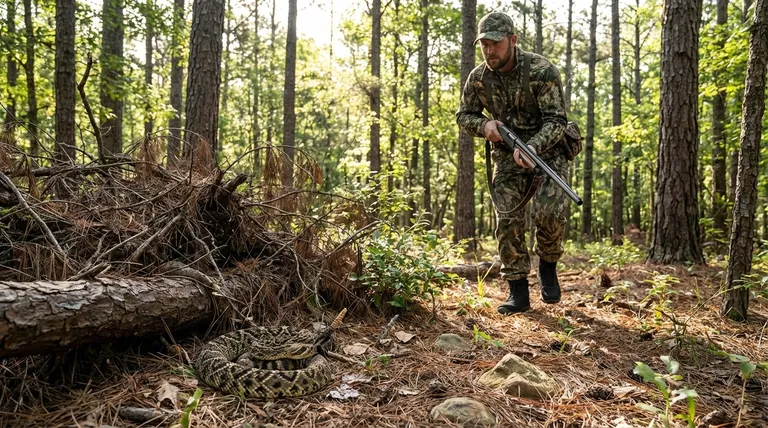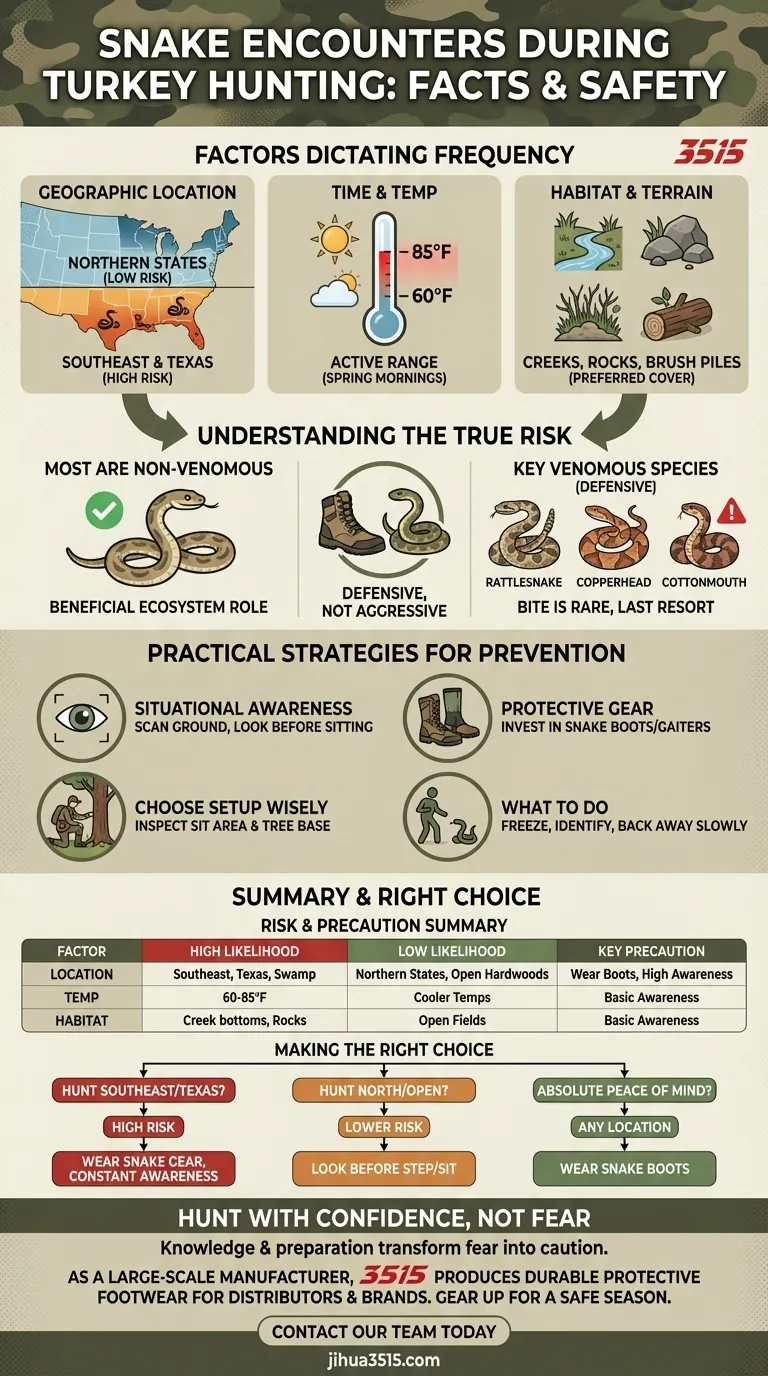There is no single answer to how common snake encounters are during turkey season; the frequency is entirely dictated by your geographic location and the local climate. For some hunters in northern states, seeing a snake is a rare event, while for those in the Southeast or Texas, it can be a regular occurrence.
While encounters are possible and even probable in certain habitats, a bite is an exceptionally rare event. The real goal is not to avoid snakes entirely, but to understand their behavior and hunt with confident awareness, transforming fear into preparedness.

Factors That Dictate Encounter Frequency
The likelihood of seeing a snake is not random. It is a predictable outcome based on a few key environmental factors that overlap directly with prime turkey hunting conditions.
Geographic Location: The Single Biggest Predictor
Your hunting grounds are the most important variable. States in the Southeast, like Georgia, Alabama, and Florida, along with Texas and other southern states, have high populations of various snake species. Conversely, hunters in cooler, northern regions will have far fewer encounters.
Time of Day and Temperature
Snakes are ectothermic, meaning they rely on external sources for body heat. They are most active when air temperatures are between 60 and 85 degrees Fahrenheit—the same comfortable conditions that make for a pleasant spring morning turkey hunt. As the day heats up, they will seek shade, just as you might.
Habitat and Terrain
Turkey and snakes often prefer similar terrain. Be particularly mindful in areas with creek bottoms, rocky outcrops, thickets, and near fallen logs or brush piles. These spots provide excellent cover and hunting grounds for snakes.
Understanding the True Risk
The fear of snakes often outweighs the actual statistical danger they pose. Understanding the difference between a possible encounter and a probable bite is critical.
Most Encounters are Non-Eventful
The vast majority of snakes you might see are non-venomous and play a beneficial role in the ecosystem. Even venomous snakes are not aggressive; their first instinct is always to hide or flee, not to attack.
Defensive, Not Aggressive
A snake bite is a defensive last resort. It typically happens when a snake is suddenly cornered, stepped on, or feels directly threatened. They do not hunt or chase people.
Key Venomous Species in Turkey Country
In North America, the primary venomous snakes you might encounter in turkey woods are rattlesnakes, copperheads, and cottonmouths/water moccasins. Familiarizing yourself with the appearance of the species in your specific hunting area is a crucial first step.
Practical Strategies for Prevention and Safety
Simple awareness and basic precautions are all that is required to make snake encounters a non-issue, allowing you to focus on your hunt.
Always Practice Situational Awareness
This is the most effective tool you have. Scan the ground before you walk. Look carefully before you sit down against a tree or log. Never reach into brush piles, hollow logs, or under rocks without looking first.
Invest in Protective Gear
For hunters in high-risk areas, a pair of quality snake boots or snake-proof gaiters provides invaluable protection and peace of mind. Most snake bites occur on the lower leg or ankle, and this gear is specifically designed to prevent fang penetration.
Choose Your Setup Location Wisely
Before you get comfortable for a long sit, take 30 seconds to scan the immediate area. Check the base of the tree you plan to lean against and the ground where you will be sitting.
What to Do During an Encounter
If you see a snake, simply freeze. This removes the perceived threat. Identify the snake from a distance if possible, then slowly back away and give it a wide berth to move on.
Making the Right Choice for Your Situation
Your personal level of preparation should match the real-world risk of your hunting environment.
- If you hunt in the Southeast, Texas, or swampy terrain: Treat snakes as a probable encounter and invest in snake boots or gaiters while practicing constant situational awareness.
- If you hunt in cooler, northern climates or open hardwoods: Your risk is significantly lower, but the fundamental principle of looking before you step or sit should always be practiced.
- If your primary goal is absolute peace of mind: Wearing snake boots is a simple and effective way to remove the concern entirely, allowing you to hunt with more confidence and focus, no matter the location.
Ultimately, knowledge and preparation transform irrational fear into respectful caution.
Summary Table:
| Factor | High Encounter Likelihood | Low Encounter Likelihood |
|---|---|---|
| Geographic Location | Southeast, Texas, Swampy Terrain | Northern States, Open Hardwoods |
| Temperature | 60-85°F (Spring mornings) | Cooler temperatures |
| Habitat | Creek bottoms, rocky outcrops, brush piles | Open fields, high ground |
| Key Precaution | Wear snake boots, high situational awareness | Basic situational awareness |
Hunt with Confidence, Not Fear
Knowledge is your best defense. For hunters in high-risk areas, proper gear and preparation are non-negotiable. As a large-scale manufacturer, 3515 produces a comprehensive range of durable and protective footwear, including options suitable for rugged terrain. Whether you are a distributor, brand owner, or a bulk client needing reliable gear for outdoor pursuits, our production capabilities ensure quality and performance.
Let us help you gear up for a safe and successful season.
Contact our team today to discuss your footwear needs and find the right solution for your hunting adventures.
Visual Guide

Related Products
- Durable Mid-Cut Tactical Boots for Wholesale & Private Label
- Wholesale Durable Mid-Cut Tactical Boots for Custom & Private Label Brands
- Durable Military Combat Boots with Water Drainage for Wholesale & OEM
- Durable Leather Work Boots for Wholesale & Custom OEM Manufacturing
- Wholesale High-Traction Camo Boots - Custom Manufacturer for Brands
People Also Ask
- How do tactical boots and combat boots differ in flexibility? Agility vs. Armor Explained
- What are the potential consequences of wearing improperly designed work boots? Avoid Injury & Boost Safety
- Why has Cordura remained relevant despite new fabrics? The Unbeatable Balance of Durability & Comfort
- What regular maintenance checks should be performed on safety boots? A Daily Safety Checklist
- Why is maintenance important for work boots? Protect Your Investment and Safety



















